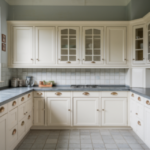Kitchen remodels are all about the details, right? And if you’re aiming for a classic yet elegant look, Newport kitchen cabinet molding is a game-changer. Not only does it bring personality to your space, but it also adds that “wow” factor that guests can’t help but notice. Let’s dive into what makes Newport molding so special and how you can use it to transform your kitchen.
Understanding Cabinet Molding
Why Molding Matters in Kitchens
Cabinet molding isn’t just a fancy add-on—it’s the cherry on top of your kitchen’s design. Think of it as the frame for a beautiful painting. It ties everything together and elevates the room from “meh” to “magnificent.” Plus, it hides those annoying gaps between cabinets and walls, giving your space a polished finish.
Different Types of Cabinet Molding
When it comes to cabinet molding, there’s a buffet of options: crown molding, base molding, and light rail molding, to name a few. Each type serves a specific purpose. Crown molding caps off the tops of cabinets for a sophisticated look. Base molding adds depth at the bottom, while light rail molding helps conceal under-cabinet lighting. The Newport style can be adapted to each of these, creating a seamless, cohesive design.
What Makes Newport Unique?
Historical Roots of Newport Style
The Newport style takes its cues from the refined, nautical elegance of Rhode Island’s coastal mansions. Inspired by the 18th-century homes of America’s elite, this style blends simplicity with opulence, making it perfect for kitchens that need a timeless yet contemporary touch.
Characteristics of Newport Molding
Newport molding is all about clean lines and subtle curves. It often features beveled edges, understated patterns, and a touch of coastal charm. The finishes? They range from natural wood tones to crisp whites and even distressed looks for a vintage vibe. Versatile and chic, Newport molding complements a variety of cabinet styles, from shaker to inset.

How to Select the Best Molding for Your Kitchen
Matching Molding to Your Cabinets
Choosing the right molding for your kitchen starts with understanding your cabinets. Are they sleek and modern, or traditional with intricate details? Newport molding is versatile enough to pair with both. For a harmonious look, match the molding’s finish to your cabinet color or opt for a complementary contrast.
Budgeting for Newport Molding
Let’s talk money—because let’s face it, kitchen upgrades can get pricey. Newport molding is known for its affordability compared to fully custom options. Still, costs can vary depending on the material and finish. Pro tip: Measure your space carefully and compare prices from multiple suppliers to avoid over-ordering.
DIY or Professional Installation?
Tools You’ll Need for Installation
If you’re the handy type, installing Newport molding yourself can save you a chunk of change. Here’s what you’ll need: a miter saw, measuring tape, wood glue, finishing nails, and a caulking gun. Oh, and patience—lots of it!
Common Mistakes to Avoid
One common mistake? Not accounting for the angles. Miter cuts can be tricky, so measure twice, cut once. Another error is skimping on adhesive or nails, which can lead to sagging over time. If DIY feels overwhelming, a pro can ensure a flawless finish.
Keeping Your Newport Molding Beautiful
Preventing Damage
Life happens—spills, bumps, and all. Protect your molding by wiping up splashes quickly and avoiding abrasive cleaners. For wooden finishes, use a gentle polish to keep them looking fresh.
Best Cleaning Practices
Cleaning Newport molding is a breeze. A soft, damp cloth works wonders for daily upkeep. For tougher grime, mix a drop of dish soap with warm water. Avoid harsh chemicals that could damage the finish, especially if you’ve opted for painted or stained wood.
Transform Your Kitchen with Newport Molding
Newport kitchen cabinet molding isn’t just an upgrade—it’s a statement. Whether you’re going for classic charm or coastal vibes, this molding style has the versatility to bring your vision to life. So, grab that inspiration board and start dreaming!
FAQs
Yes! Its clean lines make it adaptable to modern designs.
Absolutely—just make sure to use a high-quality primer and paint.
Prices vary, but you can expect to spend $2–$8 per linear foot on average.
Yes, with the right tools and some DIY skills.
Most home improvement stores and specialty cabinet suppliers stock it.







